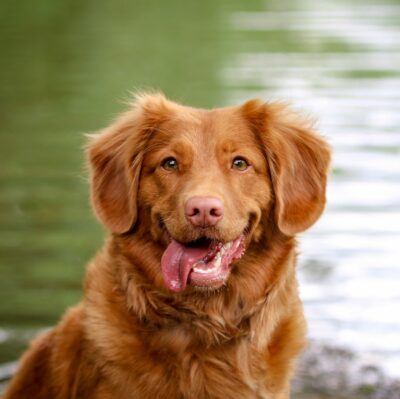
Heat
Summers in Wisconsin can get hot, and these higher temperatures can pose a threat to our dogs! Watch out for the following signs of heat stroke shared by the American Veterinary Medical Association (AVMA):
- Anxiousness
- Excessive panting
- Restlessness
- Excessive drooling
- Unsteadiness
- Abnormal gum and tongue color
- Collapse
Heat stroke can be prevented by always having water and shade available for your pet, and by keeping them inside if it’s too hot. Leaving your dog in the car during the warmer months, even if for just a few minutes, can drastically increase the risk of heat stroke. Even if you crack the windows or park in the shade, cars overheat VERY quickly and can be deadly.
As a last quick note, asphalt and concrete heat up quickly outside. If these surfaces are hot to touch, they are too hot for your pet’s paws! Walking your dogs in the mornings and evenings when it’s less sunny, or putting booties on your dog, can help prevent paw burns.


Blue-Green Algae
Blue-Green Algae is a type of bacteria that can be found in natural bodies of water, like lakes, streams, and rivers. During the summer, this cyanobacteria can bloom and produce deadly toxins. A couple of drinks of water contaminated with this bacterium can be lethal, and there is no antitoxin.
The Wisconsin Development of Health Services (DHS) describes blue-green algae as “look[ing] like spilled paint or pea soup, and can change the color of the water to green, blue, turquoise, purple, tan, or white.” Avoid letting your pet near water that matches this description. Be aware that the water can be contaminated and appear normal if the bloom is underwater.
Watch out for the following signs of poisoning, and take your dog to the nearest Veterinary Emergency Hospital immediately if you suspect exposure: vomiting, diarrhea, weakness, difficulty breathing, and/or seizures (DHS).
Creepy Crawlies
Bugs come alive in the summer! Your dog will inevitably be around them, so it’s important to be aware of which to look out for and how to best keep your dog safe and healthy.
Ticks can carry a variety of diseases that can be passed on to your dog by bite. In order to decrease the risk of transmission, you can talk to your veterinarian about monthly tick (and often flea) preventative. Even if you use a tick preventative, it’s still a good idea to look your pet over when she gets home to make sure there aren’t any attached ticks. Remove the ticks as soon as you find them.
Mosquitoes are the carriers of Heartworm, another serious and transmissible disease. This too can be managed and prevented by speaking with your vet about annual testing and monthly preventatives. Consider keeping your dog inside during times that mosquitoes are most present and active, like evenings.
Bees don’t transmit disease, but they can sting your dog and cause a reaction. Most commonly, dogs will become intrigued by the bees flying around and choose to sniff or eat them, resulting in a sting frequently on the face or legs. If your dog is stung, see if a stinger is still attached. If so, remove it carefully and hold an ice pack over the site while you contact your veterinarian for next steps. VCA (Veterinary Centers of America) recommends that you bring your dog to the nearest emergency vet immediately if you notice any of the following signs:
- Severe swelling
- Hives
- Difficulty breathing or wheezing
- Excessive drooling
- Agitation
- Vomiting and/or diarrhea
- Dizziness and/or disorientation
- Seizures


Plants and Soil Additives
Summer is the season for gardening! Unfortunately, some popular plants can be toxic to dogs (and cats) if they ingest them. Examples shared by the Pet Poison Helpline include the sago palm plant, lilies, lily of the valley, and crocuses. It’s best to research any plant that you are considering bringing to your garden or home and ensure that it is safe to have around pets. Additionally, if you see your dog ingesting a toxic plant, call your veterinarian immediately.
Plants and flowers aside, be mindful of the fertilizers and insecticides and pesticides you use in your garden. While most fertilizers are pet-friendly, ingestion of large amounts can still cause problems. Any ingestion of insecticides and pesticides can be fatal. Search for pet-safe products and consider creating a small enclosure around your garden if needed.
Sources
https://www.avma.org/resources/pet-owners/petcare/warm-weather-pet-safety
https://www.dhs.wisconsin.gov/publications/p0/p00089.pdf
https://www.cdc.gov/habs/pdf/habsveterinarian_card.pdf
https://www.petpoisonhelpline.com/poison/blue-green-algae/
https://vcahospitals.com/know-your-pet/first-aid-for-insect-stings-in-dogs

